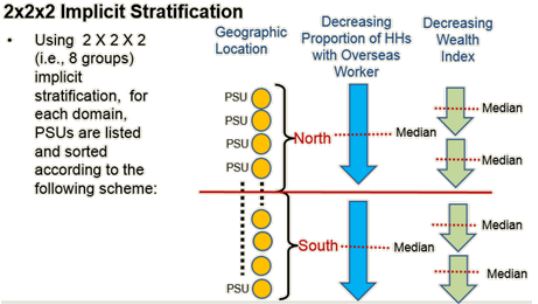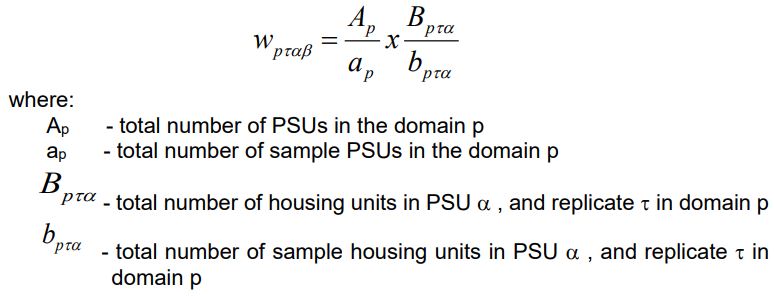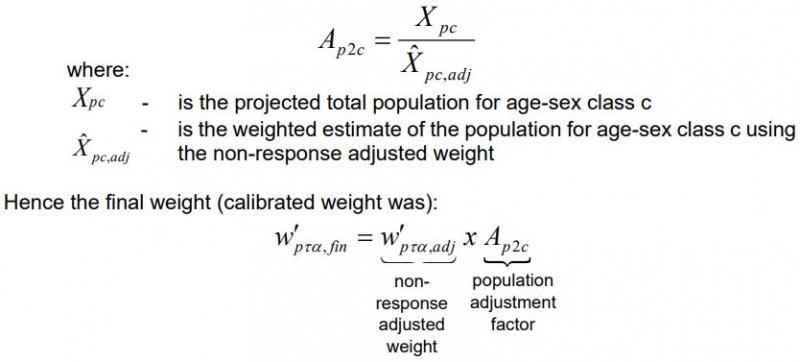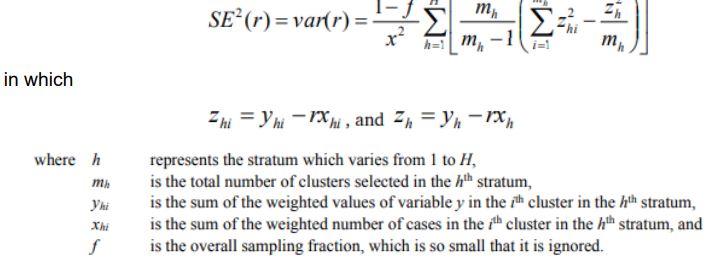I. Introduction
a. Background
The Monthly Labor Force Survey (LFS) is a nationwide survey of households conducted by the Philippine Statistics Authority (PSA) to gather data on the demographic and socio-economic characteristics of the population.
With the current Coronavirus disease 2019 (COVID-19) pandemic, there was an urgent need for a high frequency statistical information on the Philippine labor market to have a better understanding of the nature of the Philippine economy over the coming months brought about by the impacts of the health crisis. In response to this need and with the efforts to come up with accurate, reliable, and timely labor and employment statistics, the PSA conducted computational exercises to explore the possibility of estimating the labor and employment statistics on monthly basis using one replicate of the 2013 Master Sample (MS) which is equivalent to 10,692 secondary sampling units (SSUs). This is deemed sufficient for the estimation of the national estimates.
On 27 November 2020, the Interagency Committee on Labor and Productivity Statistics with some resource persons that are experts on labor economics discussed the results of the computational exercises and the plans for the conduct of the monthly LFS and recommended the conduct of the monthly LFS to the PSA Board.
On 21 December 2020, the PSA Board approved the PSA Board Resolution No. 8 Series of 2020, Approval of the Conduct of the Monthly LFS and Generation of Monthly Labor and Employment Statistics.
Starting February 2021, monthly LFS has been conducted in between quarterly or regular LFS to generate national level labor and employment statistics from the Survey.
b. Objectives
The conduct of monthly LFS aims to provide high frequency statistical information on the Philippine labor market during the unprecedented COVID-19 pandemic.
Specifically, the monthly LFS is designed to collect information on the following:
Distribution of household population 15 years old and over, by employment status, by sex, and age group;
Distribution of employed persons by major occupation group, major industry group, class of worker, number of hours worked, highest grade completed, nature of employment, and by sex;
Distribution of underemployed persons by total hours worked, major occupation group, class of worker, and by sex; and
Distribution of unemployed persons by age group, highest grade completed, and by sex.
c. Scope and Coverage
The monthly LFS is an abridged version of the quarterly or the regular LFS. It utilizes the core questions of the regular LFS with additional questions related to the COVID-19 pandemic to generate the core labor and employment indicators including relevant indicators for the COVID-19 recovery program.
With national-level as domain, survey operations for March 2022 LFS was undertaken from 08 to 28 March 2022, and covered 10,943 eligible sample households. In the statistical tables of this report, the March 2022 was compared to the January 2022 LFS, the latter has excluded Surigao del Norte and Dinagat Islands given the effect of the Typhoon Odette in these provinces.
Overseas Filipino Workers are not considered part of the labor force in the Philippines. Hence, in the LFS, data on economic characteristics of household members who are overseas workers are not collected. In the LFS report, they are excluded in the estimation of the size of working population, i.e., population aged 15 years and older, and in the estimation of the labor force.
d. Standard Classification Systems
The LFS, as in any survey, adopts standard classification systems, as follows:
2009 Philippine Standard Industrial Classification (PSIC)
2012 Philippine Standard Occupation Classification (PSOC)
2017 Philippine Standard Classification of Education (PSCED)
II. Concepts and Definitions
a. Reference Period
The reference period for this survey is the “past week” referring to the past seven days preceding the date of visit of the enumerator or the interviewer.
b. Employment Status Concepts
Population 15 Years Old and Over
This refers to number of population 15 years old and over excluding overseas workers. Overseas workers are excluded in the estimation of the size of working population (population aged 15 years and over) since the data on their economic characteristics are not collected because they are not considered part of the labor force in the country.
In the Labor Force or Economically Active Population
This refers to persons 15 years old and over who are either employed or unemployed in accordance with the definitions described below.
Employed
Employed persons include all those who, during the reference period, are 15 years old and over as of their last birthday, and are reported either:
a. At work, i.e., those who do any work even for one hour during the reference period for pay or profit, or work without pay on the farm or business enterprise operated by a member of the same household related by blood, marriage, or adoption; or
b. With a job but not at work, i.e., those who have a job or business but are not at work because of temporary illness or injury, vacation, or other reasons. Likewise, persons who expect to report for work or to start operation of a farm or business enterprise within two weeks from the date of the enumerator’s visit are considered employed.
Underemployed
Underemployed persons include all employed persons who express the desire to have additional hours of work in their present job, or an additional job, or to have a new job with longer working hours.
Visibly underemployed persons are those who work for less than 40 hours during the reference period and want additional hours of work.
Invisibly underemployed persons include employed persons who worked for 40 hours or more during the survey reference period and want additional hours of work in their present job.
Unemployed
Starting April 2005, the new unemployment definition was adopted as per National Statistical Coordination Board (NSCB) Resolution Number 15 dated October 20, 2004. As indicated in the said resolution:
Unemployed persons include all those who, during the reference period, are 15 years old and over as of their last birthday, and reported as persons:
a) Without work, i.e., had no job or business during the reference period;
b) Currently available for work, i.e., were available and willing to take up work in paid employment or self-employment during the reference period, and/or would be available and willing to take up work in paid employment or self-employment within two weeks after the interview date; and
c) Seeking work, i.e., had taken specific steps to look for a job or establish a business during the reference period, or Not seeking work due to the following reasons: (1) fatigued or believed no work available, i.e., discouraged workers; (2) awaiting results of previous job application; (3) temporary illness or disability; (4) bad weather; and/or (5) waiting for rehire or job recall.
Persons Not in the Labor Force
These refer to persons 15 years old and over who are neither employed nor unemployed. Also included are persons who are not available and are not looking for work because of the following reasons:
a. too young;
b. too old/retired;
c. permanent disability;
d. household, family duties; and
e. schooling.
Examples are housewives, students, disabled, and retired persons.
III. Sampling Design and Estimation Methodology
The March 2022 LFS used one replicate or about 10,700 sample housing units of the 2013 Master Sample through independent sampling. Using a two-stage cluster sampling design, sample Enumeration Areas (EAs)/barangays are selected at the initial sampling stage as the primary sampling units (PSUs), while sample housing units within the selected PSUs are also selected as the SSUs. Generally, all households within the sample housing unit are considered as sample households. However, for housing unit with more than three households, a maximum of three sample households are randomly selected.
Sampling Frame
The 2013 MS sampling frame was constructed based on the results of the 2010 Census of Population and Housing (2010 CPH) but which was updated using the 2015 Census of Population (POPCEN 2015). The EA Reference File (EARF) of the POPCEN 2015 was used as the PSU frame while the 2015 list of households for each of the PSU was used as the SSU frame.
Sampling Domain
The monthly 2021 LFS uses one replicate of the quarterly sample of the MS or about 10,700 sample housing units which is deemed sufficient for national estimates.
Primary Sampling Units
In the 2013 MS Design, each sampling domain (i.e., province/HUC) is divided into exhaustive and non-overlapping area segments known as PSUs with about 100 to 400 households. Thus, a PSU can be a barangay/EA or a portion of a large barangay, or two or more adjacent small barangays/EAs.
2x2x2 Implicit Stratification

The PSUs are then ordered according to the following: (1) North-South/West-East Geographic location; (2) Decreasing Proportion of Households with Overseas Worker; and (3) Decreasing Wealth Index.
Replicates
From the ordered list of PSUs, all possible systematic samples of six PSUs were drawn to form a replicate for most of the province domain or 75 out of 81 provinces. On the other hand, for the majority of highly urbanized cities, all possible systematic samples of 8 PSUs will be drawn to form a replicate. The monthly LFS uses one replicate of the quarterly LFS.
Base weight computation
The base weight is computed as the inverse of selection probability

For housing units with at most three households the base weight is computed as

For housing units with more than three households the base weight is computed as

Base Weight Adjustment
The base weight was adjusted for unit non-response and was further calibrated to conform to the known or projected population count.
For unit non-response adjustment (within domain p), the adjustment was computed as:

Applying this to the base weight, we have:

Further calibration was made to conform with known population count, as follows:

Estimation of Totals
Generally, the estimate for the weighted total for a sampling domain considering the number of sample replicate was derived using:

Estimation of Proportions
To estimate the weighted proportion p̂r in the rth region

Estimation of Sampling Error
Sampling error is usually measured in terms of the standard error for a particular statistic (mean, percentage, etc.), which is the square root of the variance.
If the sample had been selected as a simple random sample, it would have been possible to use straightforward formulas for calculating sampling errors. However, the LFS is the result of a multi-stage design, and it was necessary to use more complex formulas.
Sampling errors are computed using statistical programs. These statistical programs use the Taylor linearization method to estimate variances for survey estimates that are means, proportions, or ratios.
The Taylor linearization method treats any percentage or average as a ratio estimate, r=y/x, where y represents the total sample value for variable y, and x represents the total number of cases in the group or subgroup under consideration. The variance of r is computed using the formula given below, with the standard error being the square root of the variance:

In the LFS, the 117 province/HUC domains are also treated as natural stratification while the primary sampling units (PSUs) are treated as clusters.
Data Checking, Coding, and Filtering Prior to Estimation of Proportions
Enumeration is a highly complex operation, and it may happen that reported/encoded entries during data collection may have some omissions, and implausible/inconsistent entries. Editing is a process meant to correct these errors.
During the interview, embedded editing was activated, and errors/inconsistent entries were detected by the program. Editing was also done using Computer Aided Field Editing (CAFE) program after every interviewed household to ensure completeness and consistency of encoded entries. For monitoring of the status of data collection, LFS raw data from the tablet is uploaded to the PSA Central Office server as soon as the interview of a household/EA was completed. Review and verification of the PSOC and PSIC codes and invalid values for LFS data items were done in the provincial office using the LFS Information System (LFS IS).
Further processing in the regional office such as ID validation, and completeness check, edit, and matching of LFS sample households with the original List from MS Form 6 were done to ensure that the number of household listed was fully covered.
Preliminary and final tabulations of data were done at the PSA Central Office.
IV. Dissemination of Results
The press release of the March 2022 LFS preliminary results and the statistical tables are publicly available at the PSA website www.psa.gov.ph/statistics/survey/labor-and- employment/labor-force-survey.
VI. Contact Information
For technical concerns, you may contact the following PSA focal persons:
WILMA A. GUILLEN
Assistant National Statistician
Social Sector Statistics Service
Sectoral Statistics Office
Philippine Statistics Authority
Email address: wilms038@yahoo.com
cc: ssss.oans@gmail.com
Telephone: (632) 8376-1883
MECHELLE M. VIERNES
Chief Statistical Specialist
Income and Employment Statistics Division
Social Sector Statistics Service
Sectoral Statistics Office
Philippine Statistics Authority
Email address: psa.iesd.staff@psa.gov.ph
cc: mechelle.viernes@gmail.com
Telephone: (632) 8376-2092
For data requests, you may contact PSA focal person:
SIMONETTE A. NISPEROS
Information Officer V
Knowledge Management and Communications Division
Information Technology Statistics Division
Office of the National Statistician
Philippine Statistics Authority
Email address: info@psa.gov.ph
cc: kmcd.staff@psa.gov.ph
Telephone: (632) 8462-6600 local 839
